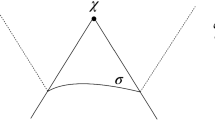Abstract
I suggest that the common unease with taking quantum mechanics as a fundamental description of nature (the “measurement problem”) could derive from the use of an incorrect notion, as the unease with the Lorentz transformations before Einstein derived from the notion of observer-independent time. I suggest that this incorrect notion that generates the unease with quantum mechanics is the notion of “observer-independent state” of a system, or “observer-independent values of physical quantities.” I reformulate the problem of the “interpretation of quantum mechanics” as the problem of deriving the formalism from a set of simple physical postulates. I consider a reformulation of quantum mechanics in terms of information theory. All systems are assumed to be equivalent, there is no observer-observed distinction, and the theory describes only the information that systems have about each other; nevertheless, the theory is complete.
Similar content being viewed by others
References
Albert, D. (1992).Quantum Mechanics and Experience, Harvard University Press, Cambridge, Massachusetts.
Albert, D., and Loewer, B. (1988).Synthese,77, 195–213.
Albert, D., and Loewer, B. (1989).Nous,23, 169–186.
Ashtekar, A. (1993). Personal communication.
Bacciagaluppi, G. (1995). A kochen-Specker theorem in the modal interpretation of quantum theory,International Journal of Theoretical Physics,34, 1205.
Bacciagaluppi, G., and Hemmo, M. (n.d.). Modal interpretations of imperfect measurement,Foundations of Physics, to appear.
Belifante, F. J. (1973).A Survey of Hidden Variable Theories, Pergamon Press, Oxford.
Bell, J. (1987). InSchrödinger: Centenary of a Polymath, Cambridge University Press, Cambridge.
Beltrametti, E. G., and Cassinelli, G. (1981).The Logic of Quantum Mechanics, Addison-Wesley, Reading, Massachusetts.
Bohm, D. (1951).Quantum Theory, Prentice-Hall, Englewood Cliffs, New Jersey.
Bohr, N. (1935).Nature,12, 65.
Bohr, N. (1949). InAlbert Einstein: Philosopher-Scientist, Open Court, La Salle, Illinois, p. 199.
Born, M. (1926).Zeitschrift für Physik,38, 803.
Bragagnolo, W., Cesari, P., and Facci, G. (1993).Teoria e metodo dell'apprendimento motorio, Societa' Stampa Sportiva, Bologna.
Breuer, (1994). The impossibility of accurate state self-measurement,Philosophy of Science.
Butterfield, J. (1995). Words, Minds and Quanta, inSymposium on Quantum Theory and the Mind, Liverpool.
Crane, L. (1995). Clock and category: Is quantum gravity algebraic?Journal of Mathematical Physics.
D'Espagnat, B. (1971).Conceptual, Foundations of Quantum Mechanics, Addison-Wesley, Reading, Massachusetts.
DeWitt, B. S. (1970).Physics Today,23, 30.
DeWitt, B. S., and Graham, N. (1973).The Many World Interpretation of Quantum Mechanics, Princeton University Press, Princeton, New Jersey.
Dirac, P. M. A. (1930).The Principles of Quantum Mechanics, Clarendon Press, Oxford.
Donald, M. (1990).Proceedings of the Royal Society of London A,427, 43.
Earman, J. (1986).A Primer on Determinism, Reidel, Dordrecht.
Einstein, A., Podolsky, B., and Rosen, N. (1935).Physical Review,47, 777.
Everett, H. (1957).Review of Modern Physics,29, 454.
Finkelstein, D. (1969). InBoston Studies in the Philosophy of Sciences, Vol. 5, R. S. Cohen and M. W. Wartofski, eds., Reidel, Dordrecht.
Finkelstein, D. (1988). InThe Universal Turing Machine, Vol. 5, R. Herken, ed., Oxford University Press, Oxford.
Fleming, N. G. (1992).Journal of Speculative Philosophy,VI(4), 256.
Gadamer, H. G. (1989).Truth and Method, Crossroad, New York.
Gell-Mann, M., and Hartle, J. (1990). InComplexity, Entropy, and the Physics of Information, W. Zurek, ed., Addison-Wesley, Reading, Massachusetts.
Ghirardi, G. C., Rimini, A., and Weber, T. (1986).Physical Review D,34, 470.
Greenberger, Horne, and Zeilinger. (1993).Physics Today.
Griffiths, R. B. (1984).Journal of Statistical Physics,36, 219.
Griffiths, R. B. (1993). In Seminar on Foundations of Quantum Mechanics, Carnegie-Mellon University, Pittsburgh (October 1993).
Halliwell. (1994). InStochastic Evolution of Quantum States in Open Systems and Measurement Process, L. Diosi, ed., Budapest.
Heisenberg, W. (1927).Zeitschrift für Physik,43, 172.
Heisenberg, W. (1936).Funf Wiener Vortage, Deuticke, Leipzig.
Hughes, R. I. G. (1989).The Structure and Interpretation of Quantum Mechanics, Harvard University Press, Cambridge, Massachusetts.
Jauch, J. (1968).Foundations of Quantum Mechanics, Addison-Wesley, Reading, Massachusetts.
Joos, E., and Zeh, H. D. (1985).Zeitschrift für Physik B,59, 223.
Kant, I. (1787).Critique of Pure Reason [English translation, Modern Library, New York (1958)].
Kent, A., and Dowker, F. (1994). On the consistent histories approach to quantum mechanics, preprint [pampt/94–48].
Landau, L. D., and Lifshitz, E. M. (1977).Quantum Mechanics, Pergamon Press, Oxford, Introduction.
Lockwood, M. (1989).Mind Brain and the Quantum, Blackwell, Oxford.
Mackey, G. W. (1963).Mathematical Foundations of Quantum Mechanics, Benjamin, New York.
Maczinski, H. (1967).Bulletin de l'Academic Polonaise des Sciences,15, 583.
Maturana, H., and Varela, F. (1980).Autopoiesis and Cognition. The Realization of the Living, Reidel, Dordrecht.
Messiah, A. (1958).Quantum Mechanics, Wiley, New York.
Newman, E. T. (1993). Talk at the inaugural ceremony of the Center for Gravitational Physics, Penn State University, August 1993.
Omnès, R. (1988).Journal of Statistical Physics,57, 357.
Penrose, R. (1989).The Emperor's New Mind, Oxford University Press, Oxford.
Peres, A., and Zurek, W. H. (1982).American Journal of Physics,50, 807.
Piron, C. (1972).Foundations of Physics,2, 287.
Primas, H. (1990). InSixty-Two Years of Uncertainty, A. I. Miller,ed., Plenum Press, New York.
Roessler, O. E. (1987). InReal Brains—Artificial Minds, J. L. Casti and A. Karlqvist, eds., North-Holland, Amsterdam.
Rovelli, C. (1995). Half way through the woods—Contemporary physics of space and time, inAnnual Lectures at the Center for the History and Philosophy of Science, Pittsburgh University, in press.
Shannon, C. E. (1949).The Mathematical Theory of Communications, University of Illinois Press, Champaign-Urbana, Illinois.
Shimony, A. (1969). InQuantum Concepts and Spacetime, R. Penrose and C. Isham, eds., Clarendon Press, Oxford.
Schrödinger, E. (1935).Naturwissenshaften,22, 807.
Van Fraassen, B. (1991).Quantum Mechanics: An Empiricist View, Oxford University Press, Oxford.
Von Neumann, J. (1932).Mathematische Grundlagen der Quantenmechanik, Springer, Berlin.
Wheeler, J. A. (1957).Reviews of Modern Physics,29, 463.
Wheeler, J. A. (1988).IBM Journal of Research and Development,32, 1.
Wheeler, J. A. (1989). InProceedings of the 3rd International Symposium on the Foundations of Quantum Mechanics, Tokyo.
Wheeler, J. A. (1992). It from bit and quantum gravity, Princeton University Report.
Wheeler, J., and Zureck, W. (1983).Quantum Theory and Measurement, Princeton University Press, Princeton, New Jersey.
Wigner, E. P. (1961). Inthe Scientist Speculates, Good, ed., Basic Books, New York.
Zureck, W. H. (1981).Physical Review D,24, 1516.
Zureck, W. H. (1982).Physical Review D,26, 1862.
Author information
Authors and Affiliations
Rights and permissions
About this article
Cite this article
Rovelli, C. Relational quantum mechanics. Int J Theor Phys 35, 1637–1678 (1996). https://doi.org/10.1007/BF02302261
Received:
Issue Date:
DOI: https://doi.org/10.1007/BF02302261




